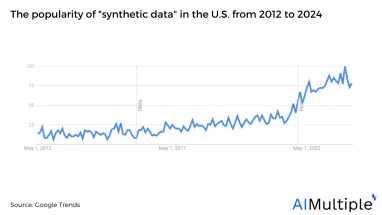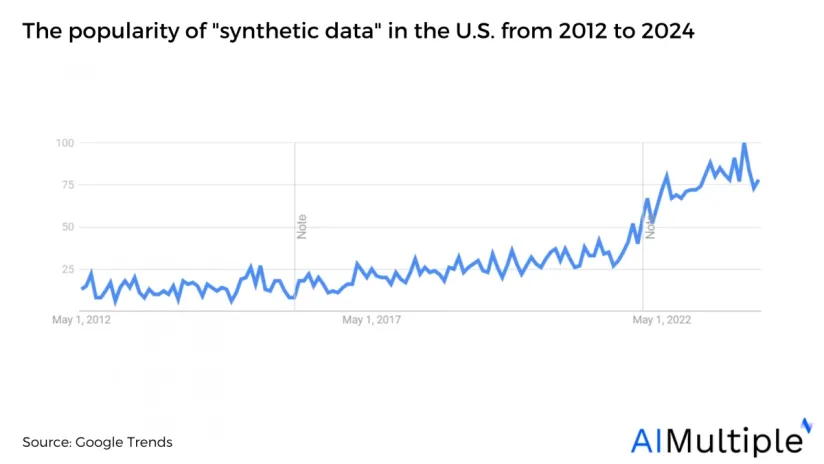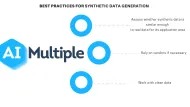Top 20 Synthetic Data in 2024: 20 Use Cases & Applications


Synthetic data, also called artificially generated data, provides solutions for problems often encountered in data science applications such as data privacy and small data size. We listed the capabilities and most common use cases of synthetic data in different industries and departments/business units.
What are industry-agnostic use cases enabled by synthetic data?
Data sharing with third parties
Read more: Supply chain data sharing.
Internal data sharing
- Data privacy regulations not only restrict data sharing between organizations but also prevent the flow of data within an organization. Getting data access permissions can take weeks which can hinder collaboration. Organizations can speed up innovation with enhanced collaboration between teams by leveraging synthetic data.
Cloud migration
- Cloud services offer a range of innovative products for many sectors. However, moving private data to cloud infrastructures involves security and compliance risks. In some cases, moving synthetic versions of sensitive data to the cloud can enable organizations to take advantage of the benefits of cloud services. This is not possible for all use cases. For example,
Read more: Cloud migration.
Data retention
- Regulations also limit how long a business can store personal data. This is a problem for long-term analyses such as detecting the seasonality of data over several years. Synthetic data provides a way to comply with data retention regulations without undermining long-term analytics capabilities.
Read more: Data management.
What are synthetic data use cases in different industries and sectors?
Financial services
- Fraud identification is a major part of any financial service, but fraudulent transactions are rare. With synthetic fraud data, new fraud detection methods can be tested and evaluated for their effectiveness.
- Customer intelligence: Synthetic customer transaction data can be used to perform analysis on customer data to understand customer behavior. This is similar to the use case on “internal data sharing” however it is applicable more widely in finance where most customer data is private.
For more on the use cases of synthetic data in finance, check our article on the topic.
Manufacturing
- Quality assurance: As Leo Tolstoy states at the beginning of Anna Karenina: “All happy families are alike; each unhappy family is unhappy in its own way.” It is hard to test a system to see whether it identifies anomalies since there are infinitely many anomalies. Synthetic data enables more effective testing of quality control systems, improving their performance.
Healthcare
- Healthcare analytics: Synthetic data enables healthcare data professionals to allow the internal and external use of record data while still maintaining patient confidentiality. This is similar to the use case on “internal data sharing” however it is applicable more widely in healthcare where most customer data is private.
- Clinical trials: Synthetic data can be used as a baseline for future studies and testing when no real data yet exists.
For more on the use cases of synthetic data in healthcare, check our article on the topic.
Automotive and Robotics
Autonomous Things (AuT): Research to develop autonomous things such as robots, drones, and self-driving car simulations pioneered the use of synthetic data. This is because real-life testing of robotic systems is expensive and slow. Synthetic data enables companies to test their robotics solutions in thousands of simulations, improving their robots and complementing expensive real-life testing.
- Self-driving cars
- Autonomous robots
Security
Synthetic data can be used to secure organizations’ online & offline properties. Two methods are commonly used:
- Training data for video surveillance: To take advantage of image recognition, organizations need to create and train neural network models, but this has two limitations: Acquiring the volumes of data and manually tagging the objects. Synthetic data can help train models at a lower cost compared to acquiring and annotating training data.
- Deep fakes: Deep fakes can be used to test face recognition systems.
Social Media
Social networks are using synthetic data to improve their various products:
- Testing content filtering systems: Social networks are fighting fake news, online harassment, and political propaganda from foreign governments. Testing with synthetic data ensures that the content filters are flexible and can deal with novel attacks.
What are synthetic data use cases in different departments or functions?
Agile development and DevOps
- For software testing and quality assurance, artificially generated data is often the better choice as it eliminates the need to wait for ‘real’ data. Often referred to under this circumstance as ‘test data’. This can ultimately lead to decreased test time and increased flexibility and agility during development
HR
- Employee datasets of companies contain sensitive information and are often protected by data privacy regulations. In-house data teams and external parties may not have access to these datasets but they can leverage synthetic employee data to conduct analyses. It can help companies to optimize HR processes.
Marketing
- Synthetic data allows marketing units to run detailed, individual-level simulations to improve their marketing spend. Such simulations would not be allowed without user consent due to GDPR. However synthetic data, which follows the properties of real data, can be reliably used in simulation.
Machine learning
- Most ML models require large amounts of data for better accuracy. Synthetic data can be used to increase training data size for ML models.
- Prediction of rare events such as fraud or manufacturing defects is hard since small data size leads to inaccuracies for ML models. Generating synthetic instances of such events increases model accuracy.
- Synthetic data generation creates labeled data instances, ready to be used in training. This reduces the necessity for time-consuming data labeling efforts.
Check AIMuliple’s data-driven list of synthetic data generator vendors.
If you still have questions about synthetic data, feel free to contact us:

Cem has been the principal analyst at AIMultiple since 2017. AIMultiple informs hundreds of thousands of businesses (as per similarWeb) including 60% of Fortune 500 every month.
Cem's work has been cited by leading global publications including Business Insider, Forbes, Washington Post, global firms like Deloitte, HPE, NGOs like World Economic Forum and supranational organizations like European Commission. You can see more reputable companies and media that referenced AIMultiple.
Throughout his career, Cem served as a tech consultant, tech buyer and tech entrepreneur. He advised businesses on their enterprise software, automation, cloud, AI / ML and other technology related decisions at McKinsey & Company and Altman Solon for more than a decade. He also published a McKinsey report on digitalization.
He led technology strategy and procurement of a telco while reporting to the CEO. He has also led commercial growth of deep tech company Hypatos that reached a 7 digit annual recurring revenue and a 9 digit valuation from 0 within 2 years. Cem's work in Hypatos was covered by leading technology publications like TechCrunch and Business Insider.
Cem regularly speaks at international technology conferences. He graduated from Bogazici University as a computer engineer and holds an MBA from Columbia Business School.
To stay up-to-date on B2B tech & accelerate your enterprise:
Follow on
Comments
Your email address will not be published. All fields are required.